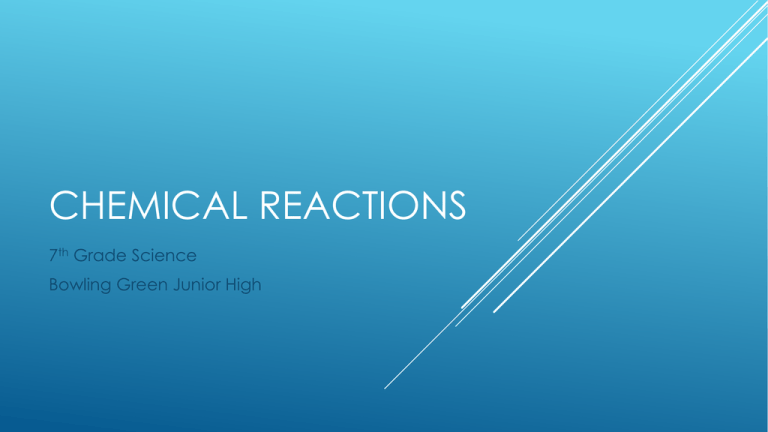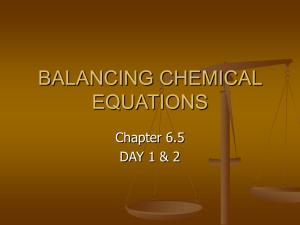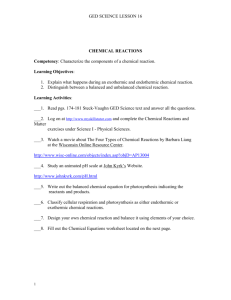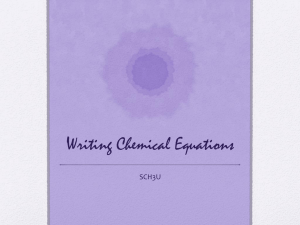Chemical Reactions - Bowling Green City Schools
advertisement

CHEMICAL REACTIONS 7th Grade Science Bowling Green Junior High WHAT ARE CHEMICAL REACTIONS? Chemical Reaction – a change that takes place when two or more substances (reactants) interact to form new substances (products) with new properties. COMPOUNDS Matter made of two or more different elements chemically bonded. Cannot be separated by physical means Has properties that are different from the elements that make it up. MORE COMMON THAN ELEMENTS DUE TO MANY ELEMENTS BEING REACTIVE WITH EACH OTHER THE ELEMENTS THAT COMBINE MAKE A NEW SUBSTANCE WITH NEW PHYSICAL PROPERTIES FOR A COMPOUND TO FORM OR BE BROKEN DOWN, A CHEMICAL REACTION MUST TAKE PLACE NaCl + = TABLE SALT Respiration (breathing) Photosynthesis Grilling food Starting a vehicle Digestion Rusting metal EVERYDAY EXAMPLES OF CHEMICAL REACTIONS HOW DO YOU KNOW WHEN A CHEMICAL REACTION HAS TAKEN PLACE? A new substance with new properties is formed SIGNS OF A CHEMICAL REACTION Temperature FIZZES Change (heat given off or required) OR BUBBLES COLOR CHANGE ODOR LIGHT NEW GIVEN OFF SUBSTANCE FORMED Precipitate (solid) Precipitate (gas bubbles) TWO PARTS OF A CHEMICAL REACTION Reactants – Substances that start a chemical reaction (EX: chemicals on match head) Products – Substances produced in the reaction (EX: black material on match) CHEMICAL EQUATIONS • Chemical equations are symbols used to describe the details of a chemical reaction. • Shows how the reactants changed into the product. • This involves indicating all the atoms involved in the reaction. Fe + O2 Reactants: Iron and oxygen Plus Sign: Shows substances combine Reactants are ALWAYS to the left of the arrow FeO2 Arrow: Means “yields” takes the place of an = sign Product: Ferrous oxide (rust) Products are ALWAYS to the right of the arrow TYPES OF CHEMICAL REACTIONS Combustion Synthesis Decomposition Single replacement Double replacement Neutralization Oxidation/Reduction Hydrolysis Endothermic/Exothermic WHAT DO YOU HAVE TO HAVE TO BURN SOMETHING? COMBUSTION REACTIONS When oxygen (O2) combines with another compound to form water and carbon dioxide. Needs Takes Fast a fuel source place at high temperatures process that results in an increase of temperature and production of fire. Chemical reactions can be classified Combustion Reaction – always involves oxygen (O ) 2 as a reactant. CH4 + 2O2 Methane H H C Oxygen O O H H + O O CO2 + 2H2O Water Carbon Dioxide + 4 TYPES OF REACTIONS SYNTHESIS REACTIONS Two or more substances react to form a new substance(s) A + B AB S + O2 SO2 CHEMICAL REACTIONS CAN BE CLASSIFIED Synthesis Reaction – combines two or more simpler reactants to form new, more complex products. N2 + 2O2 Nitrogen N N Oxygen + 2NO2 Nitrogen Dioxide OO OO Simple to complex DECOMPOSITION REACTION One substance breaks down into two or more simpler substances AB A+B CaCO3 CaO + CO2 Chemical reactions can be classified Decomposition reaction – breaks a reactant into two or more simpler products 2H2O Water H O 2H2 + O2 Oxygen Hydrogen H + H Complex to simple O H SINGLE REPLACEMENT One element replaces another element in a compound AB + C AC + B Zn + 2HCl H2 + ZnCl2 Chemical reactions can be classified Replacement Reaction – elements switch places to form new compounds. 1) Single Replacement Zn + Zinc Zn + 2HCl Hydrochloric Acid Cl H ZnCl2 + Zinc Chloride Cl H + Cl H Cl H H2 Hydrogen DOUBLE REPLACEMENT Elements from two different compounds switch places AB + CD AC + BD HCl + NaOH NaCl + H2O Chemical reactions can be classified Replacement Reaction – elements switch places to form new compounds. Double Replacement FeS + 2HCl Iron Sulphide Fe S Hydrochloric Acid + Cl H Cl H FeCl2 + Iron Chloride H2 S Hydrogen Sulfide + All chemical reactions are going to release (give off) energy or absorb (take in) energy. Some will require energy to start the reaction (activation energy) EX: before you use a new cell phone, what’s got to happen? Activation energy=energy required to start a chemical reaction. ENDOTHERMIC VS. EXOTHERMIC PROCESSES EXOTHERMIC REACTIONS OR PROCESSES Exothermic reactions are exactly the opposite. While they take some energy to get going, called the activation energy of reaction, these reactions give off heat during the reaction Good examples of exothermic reactions are explosions like fireworks or combustion in engines. Forming a chemical bond releases energy and is exothermic Usually feel hot because it is giving heat to you ENDOTHERMIC REACTIONS OR PROCESSES Endothermic reactions are those which absorb heat during the reaction. They take in more energy than they give off, which leaves the surroundings cooler than the starting point Evaporation of water by sunlight is a great example. The sun and the liquid water combine and the water absorbs energy and eventually becomes as gas. Breaking a chemical bond requires energy and is endothermic Usually feel cold because it is taking heat away from you CATALYST Substance which speeds up a chemical reaction but is chemically unchanged at the end of the reaction. •The catalytic converter in a car contains platinum, which serves as a catalyst to change carbon monoxide, which is toxic, into carbon dioxide. •If you light a match in a room with hydrogen gas and oxygen gas, there will be an explosion and most of the hydrogen and oxygen will combine to create water molecules. A way of writing which type of atoms and how many of each there are in a compound. CHEMICAL FORMULAS Written as: C4H10 Butane Written as: CH4 Methane = how many total molecules Subscripts= how many atoms COUNTING ATOMS FeO2 H2O CO2 MgBr2 C6H12O6 3OH 2H2O COUNTING ATOMS IN CHEMICAL EQUATIONS 2Na + MgF2 2NaF + Mg 2K + Cl2 2KCl COUNTING ATOMS IN CHEMICAL EQUATIONS 2Na2O 4Na + O2 COUNTING ATOMS IN CHEMICAL EQUATIONS Law of Conservation of Matter Matter cannot be created or destroyed, it just changes forms. *The total mass of the reactants MUST EQUAL the total mass of the product. Law of Conservation of Mass Alka-Seltzer and Water http://www.skyweb.net/science/balancing_chemical_equations_examples.htm BALANCING EQUATIONS • The number of atoms of the reactants must equal the number of atoms in the product. (Law of Conservation of Matter) Ex: 2Na + Cl2 -> 2NaCl 4P + 5O2 -> P4O10 BALANCING EQUATIONS • Rules – Make sure that all atoms are equal on both sides. – You can only add coefficients. • Changing the subscripts will change the identity of the compound. – H2O & H2O2 EX: 2Na + Cl2 -> 2NaCl H2 + O2 -> 2H2O (Not balanced… So…) 2H2 + O2 -> 2H2O Balancing Chemical Equations Hg + O2 HgO H2 + Cl HCl Mg + O2 MgO O2 + H 2 H 2O CH4 + O2 CO2 + H2O Fe + Cl2 FeCl3 Hg + O2 HgO H2 + Cl HCl Mg + O2 MgO O2 + H2 H2O Fe + Cl2 FeCl3 CH4 + O2 CO2 + H2O






